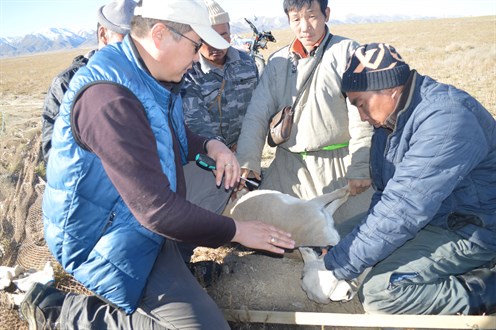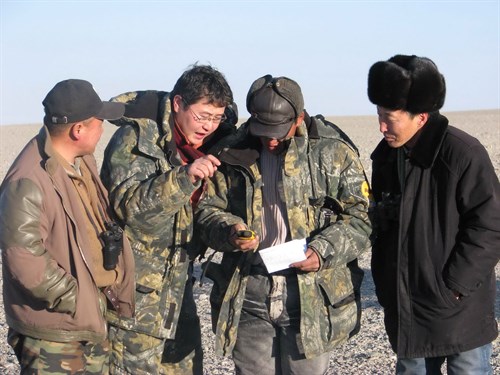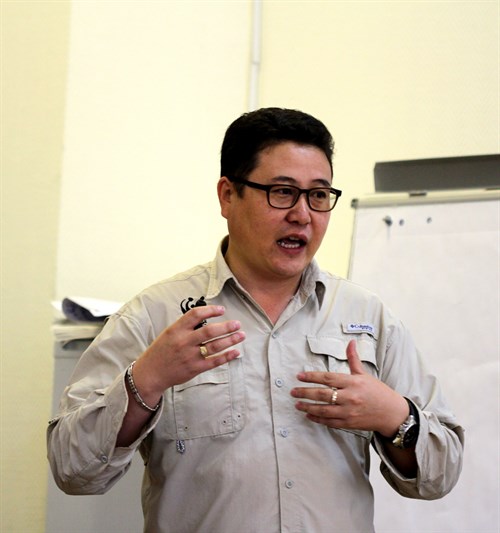Buyanaa Сhimeddorj,
This month's Saiga Hero is Chimeddorj Buyanaa who works tirelessly in Monglia to save this beautiful species
Editor: When did you first become interested in saigas?
B.Ch.:I was born and spent my childhood in Uvs province, Western Mongolia, where we have the most pristine zones with rich biodiversity. At that time, my curiosity and fascination with nature started. After that, my interest grew so much I decided to pursue biology at the National University of Mongolia and become interested in Mongolia's rare and endangered animals, including the Mongolian saiga antelope.
Editor: When did you start to work on saiga research and conservation?

B.Ch.:In 2005, I was invited by WWF-Mongolia to help them to explain the achievements of their saiga conservation project to a representative from a donor organization. Later, in 2006, I was invited to carry out a feasibility study on the restoration of the Mongolian saiga in the Great Lakes Basin of Western Mongolia. For this, I gained knowledge about the ecology and biology of the Mongolian saiga and gained a great interest in conservation science and management of natural resources. Based on the results of this feasibilty study, WWF-Mongolia successfully raised substantial financial help from the MAVA Foundation for Mongolian saiga conservation.
Editor: What is your usual day like?
B.Ch.:I give professional advice to the saiga ranger network through their leader and ensure that they are carrying out coordinated and science-based monitoring and conservation work. In order to do this, I felt the need to acquire an intimate network of scientists, local wildlife managers and rangers. In addition to my work as a biologist, I also take care of planning of activities and managing budgets and project implementation reports, which I consider just as important.
Editor: What are the fundamental problems in your work?
B.Ch.:The Mongolian saiga antelope is a highly vulnerable subspecies. The total population numbered 15,000 individuals as of 2014, which has increased over the past years after a population crash at the start of the century (caused by a dzud, a natural disaster, in the winter of 2001-2002, leaving only 750 animals).
Key threats to the Mongolian saiga's survival include poaching and the illegal horn trade (saiga horns are also known as ling yang (羚羊) and used in Traditional Chinese Medicine), competition with livestock for critical habitats, climate change and the road network. In addition, sadly, the fate of the Mongolia saiga is currently in jeopardy from an epidemic of peste-des-petits-ruminants (PPR), a viral disease of ruminants.
Editor: What can be done to remove impediments in your work?

B.Ch.:A suitable grazing regime and reduced numbers of livestock are key responses to the increasing impact of climate change on both Saiga survival and herders' livelihoods. Key to decreasing the livestock populations will be the identification of market opportunities for livestock commodities (e.g. meat and skins). Therefore, we should raise additional funds for piloting market-based options for sustainable pasture management without affecting herders' livelihoods. Furthermore, environmentally-friendly pasture management has started in selected areas; the community group in Darvi and Durgun (Shargiin Gobi, Durgun steppe) restored four wells to improve water availability for people, livestock and wildlife, reducing conflict for open water in core Saiga habitats but these local initiatives are not sufficient to solve the problem throughout the saiga's range.
We need to continue to support the volunteer saiga ranger network (SRN) and the Mobile Anti-poaching unit (MAPU) and inter law enforcement agency cooperation. The poaching and trade of horn situation is still volatile as shown the poaching cased in last several years. Education and public awareness programme should primarily focus on changing herders' attitudes towards adopting sustainable pasture management. Another special emphasis shall be put on addressing illegal poaching and trade of saigas.
To ensure the long term survival of the species, it's crucial to have more than one population to prevent a single natural extreme event (e.g. harsh winter and infectious disease) wiping out the entire population. Therefore, we should rebuild new populations in former habitats to establish a meta-population structure to safeguard the subspecies from the extinction.
Editor: What do you consider the best thing in your work?
 B.Ch.:Involvement of local stakeholders, particularly the support of local herders for conservation, is crucial. Participatory planning and the participatory decision-making process is as important as reaching the conservation goal itself.
B.Ch.:Involvement of local stakeholders, particularly the support of local herders for conservation, is crucial. Participatory planning and the participatory decision-making process is as important as reaching the conservation goal itself.
Editor: What has changed over the time you have worked in species conservation, and what are the current trends in conservation?
B.Ch.:Since 1998, with financial assistance from the MAVA and other sources, WWF-Mongolia has implemented several projects on saiga conservation that have reversed the saiga population decrease for the first time in the past two decades. These results are inspiring but the foundation we have built is still fragile and external pressures from unsustainable livestock husbandry practices, demand for saiga horn, disease, natural disasters and lack of knowledge could easily erode these initial successes.
Editor: What do you think about the current Mongolian saiga death due to PPR and what should be done to protect the Mongolian saiga from becoming extinct?
B.Ch.:Given the epidemiology of PPR and its airborne spread, saiga aggregations of several hundred animals are likely to be affected for as long as 3 months after the index case, which means the outbreak could be expected to last until the end of spring. Therefore, the main preventive measure is to strengthen law enforcement and conduct regular inspections. This is because, the poachers and horn collectors are intensifying their activities to take advantage of the mass death of the saiga. Horns and body parts collected from dead carcasses will likely increase the risk of the pathogen spreading more quickly and into new areas. Furthermore, all livestock must be immunised and the ongoing situation monitored continuously.
